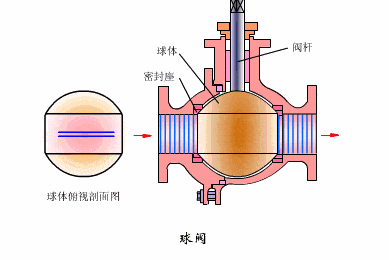Ball valve structure schematic diagram
Posted by Bundor valve
Ball valve came out in the 1950s. With the rapid development of science and technology, the continuous improvement of production technology and product structure, ball valve has rapidly developed into a major valve type in just 40 years. In the industrialized countries , the use of ball valve is increasing by years.
In developing countries, ball valves are widely used in petroleum refining, long-distance pipelines, chemical industry, paper making industry, pharmaceuticals, water conservancy, electric power, municipal administration, steel and other industries, and play a significant role in the national economy.
The disc of the ball valve is a sphere with a circular channel, which rotates around an axis perpendicular to the channel, and the ball rotates with the valve stem to achieve the purpose of opening or closing the channel. The ball valve can be closed tightly only with 90 degree rotation operation and small rotation torque. According to the requirements of the working conditions, different driving devices can be assembled to form ball valves with different control methods, such as electric ball valves, pneumatic ball valves, hydraulic ball valves, etc.
Working principle of ball valve:

When the ball valve is rotated 90 degrees, the inlet and outlet should be fully rendered sphere, the valve will be closed and the medium will be cut off. When the ball valve turn back 90 degrees, the inlet and outlet should be fully rendered ball, the medium begins to flow, there is basically no flow resistance.
Advantages of ball valve:
1. The ball valve is not restricted by the installation direction, and the flow direction of the medium can be arbitrary. The fluid resistance is small, and the ball valve with full bore basically has no flow resistance.
2. The ball valve has two sealing surfaces. At present, various plastics are widely used in the sealing surface materials of the ball valve, which has good sealing performance and can achieve complete sealing. It is also widely used in vacuum system.
3. The ball valve is suitable for frequent operation, with quick and light opening and closing. It is easy to operate and fast to open and close. It only needs to rotate 90 degrees from fully open to fully closed, which is convenient for long-distance control.
4. The ball valve has a simple structure, and the sealing ring is generally movable, which is convenient to disassemble and replace.
5. When the valve is fully open or closed, the sealing surface of the ball and the valve seat shall be isolated from the medium. When the medium passes through, the valve sealing surface will not be eroded.
6. It can be used in a wide range of applications, such as diameter ranging from several millimeters to several meters, pressure from high vacuum to high pressure can be applied.
7. The ball valve can be used in the medium with suspended solid particles due to its wiping property in the process of opening and closing.
8. The ball valve has small fluid resistance, no vibration and low noise.
In developing countries, ball valves are widely used in petroleum refining, long-distance pipelines, chemical industry, paper making industry, pharmaceuticals, water conservancy, electric power, municipal administration, steel and other industries, and play a significant role in the national economy.
The disc of the ball valve is a sphere with a circular channel, which rotates around an axis perpendicular to the channel, and the ball rotates with the valve stem to achieve the purpose of opening or closing the channel. The ball valve can be closed tightly only with 90 degree rotation operation and small rotation torque. According to the requirements of the working conditions, different driving devices can be assembled to form ball valves with different control methods, such as electric ball valves, pneumatic ball valves, hydraulic ball valves, etc.
Working principle of ball valve:

When the ball valve is rotated 90 degrees, the inlet and outlet should be fully rendered sphere, the valve will be closed and the medium will be cut off. When the ball valve turn back 90 degrees, the inlet and outlet should be fully rendered ball, the medium begins to flow, there is basically no flow resistance.
Advantages of ball valve:
1. The ball valve is not restricted by the installation direction, and the flow direction of the medium can be arbitrary. The fluid resistance is small, and the ball valve with full bore basically has no flow resistance.
2. The ball valve has two sealing surfaces. At present, various plastics are widely used in the sealing surface materials of the ball valve, which has good sealing performance and can achieve complete sealing. It is also widely used in vacuum system.
3. The ball valve is suitable for frequent operation, with quick and light opening and closing. It is easy to operate and fast to open and close. It only needs to rotate 90 degrees from fully open to fully closed, which is convenient for long-distance control.
4. The ball valve has a simple structure, and the sealing ring is generally movable, which is convenient to disassemble and replace.
5. When the valve is fully open or closed, the sealing surface of the ball and the valve seat shall be isolated from the medium. When the medium passes through, the valve sealing surface will not be eroded.
6. It can be used in a wide range of applications, such as diameter ranging from several millimeters to several meters, pressure from high vacuum to high pressure can be applied.
7. The ball valve can be used in the medium with suspended solid particles due to its wiping property in the process of opening and closing.
8. The ball valve has small fluid resistance, no vibration and low noise.
 简体中文
简体中文 Русский
Русский Español
Español Bundor - Butterfly, Gate, Check, Ball, Globe Valve Manufacturer, Supplier & Distributor
Bundor - Butterfly, Gate, Check, Ball, Globe Valve Manufacturer, Supplier & Distributor
